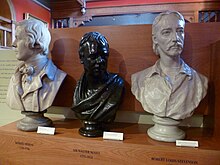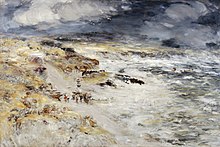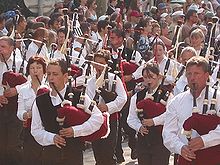Culture of Scotland
| Part of a series on the |
| Culture of Scotland |
|---|
 |
| People |
|
Folklore |
| Cuisine |
| Religion |
| Art |
| Literature |
The culture of Scotland refers to the patterns of human activity and
Scots law
Scotland retains
Banking and currency
Banking in Scotland also features unique characteristics. Although the Bank of England remains the central bank for the UK Government, three Scottish corporate banks still issue their own banknotes: the Bank of Scotland, the Royal Bank of Scotland and the Clydesdale Bank.
Sports
Scotland competes in sporting events such as the
Scotland is the "Home of
Literature

The earliest extant literature written in what is now Scotland, was composed in Brythonic speech in the sixth century and has survived as part of Welsh literature.[2] In the following centuries there was literature in Latin, under the influence of the Catholic Church, and in Old English, brought by Anglian settlers. As the state of Alba developed into the kingdom of Scotland from the eighth century, there was a flourishing literary elite who regularly produced texts in both Gaelic and Latin, sharing a common literary culture with Ireland and elsewhere.[3] After the Davidian Revolution of the thirteenth century a flourishing French language culture predominated, while Norse literature was produced from areas of Scandinavian settlement.[4] The first surviving major text in Early Scots literature is the fourteenth-century poet John Barbour's epic Brus, which was followed by a series of vernacular versions of medieval romances. These were joined in the fifteenth century by Scots prose works.[5][6]
In the early modern era royal patronage supported poetry, prose and drama.
In the 20th century there was a surge of activity in Scottish literature, known as the
Art

The earliest examples of art from what is now Scotland are highly decorated carved stone balls from the
In the eighteenth century Scotland began to produce artists that were significant internationally, all influenced by
Scotland possess significant collections of art, such as the
Music
Scotland is internationally known for its traditional music, which remained vibrant throughout the 20th century and into the 21st, when many traditional forms worldwide lost popularity to pop music. In spite of emigration and a well-developed connection to music imported from the rest of Europe and the United States, the music of Scotland has kept many of its traditional aspects; indeed, it has itself influenced many forms of music.
Media
Scotland's media are partly separate from the rest of the UK. For example, Scotland has several national newspapers, such as the
Regional dailies include
Scotland has its own
Two
As one of the Celtic nations, Scotland is represented at the

Fair fa' your honest, sonsie face,
Great chieftain o' the puddin-race!
Food and drink
Although the
.Scotland is also known for its
The soft drink Irn-Bru is cited by its manufacturer A.G. Barr as Scotland's 'other' national drink owing to its large market share in Scotland outselling major international brands such as Coca-Cola.
Philosophy
Scotland has a strong philosophical tradition.
Folklore
Language and religion
Scotland also has its own unique family of languages and dialects, helping to foster a strong sense of "Scottish-ness". See
Forms of
The
Interceltic festivals

As one of the Celtic nations, Scotland is represented at interceltic events at home and around the world. Scotland is host to two interceltic music festivals – the Scottish Arts Council funded Celtic Connections, Glasgow, and the Hebridean Celtic Festival, Stornoway – that were founded in the mid-1990s.[63][64][65][66]
Scottish culture is also represented at interceltic festivals of music and culture worldwide. Among the most well known are Festival Interceltique de Lorient – held annually in Brittany since 1971 – the Pan Celtic Festival, Ireland, and the National Celtic Festival, Portarlington, Australia.[67][68][69]
National symbols
See also
- Architecture of Scotland
- A Drunk Man Looks at the Thistle
- Bard's blessing
- Homecoming Scotland 2009
- Scots language
- Scottish cringe
- Scottish Gaelic language
- Scottish mythology
- Scottish national identity
- Scottish people
- Tartanry and List of tartans
References
- ^ "Scottish athletics and Wales competing in two leagues, the top four teams from each league qualifying for a final knockout cup competition".
{{cite web}}: Missing or empty|url=(help) - ISBN 0-313-30054-2, p. 508.
- ISBN 0521189365, p. 19.
- ISBN 0748612998, p. 220.
- ISBN 81-269-0041-5, p. 23.
- ISBN 0-7486-0276-3, pp. 60–7.
- ISBN 0-7486-1615-2, pp. 256–7.
- ISBN 0-7073-0367-2, pp. 1–2.
- ISBN 0-08-037728-9, pp. 137–8.
- ISBN 0-06-055888-1
- ISBN 0-06-055888-1
- ISBN 0-19-538623-X, pp. 216–9.
- ^ "Cultural Profile: 19th and early 20th century developments", Visiting Arts: Scotland: Cultural Profile, archived from the original on 30 September 2011
- ^ "The Scottish 'Renaissance' and beyond", Visiting Arts: Scotland: Cultural Profile, archived from the original on 30 September 2011
- ^ The Scots Makar, The Scottish Government, 16 February 2004, archived from the original on 4 February 2012, retrieved 28 October 2007
- ^ "Duffy reacts to new Laureate post", BBC News, 1 May 2009, archived from the original on 30 October 2011
- ^ "Carved stone ball found at Towie, Aberdeenshire", National Museums of Scotland, retrieved 14 May 2012.
- ^ V. G. Childe, The Prehistory Of Scotland (London: Taylor and Francis, 1935), p. 115.
- ISBN 978-0-8196-1160-4, p. 25.
- ISBN 0-7486-0641-6, pp. 7–8.
- ISBN 0-7141-0554-6, pp. 26–8.
- ISBN 1843836289, p. 5.
- ISBN 0-333-56761-7, pp. 127–9.
- ISBN 0-7486-0276-3, pp. 57–9.
- ISBN 1859735088, p. 102.
- ISBN 0-19-162433-0, pp. 198–9.
- ISBN 0-19-162243-5.
- ISBN 1-902669-73-8, pp. 142–3.
- ISBN 0-7546-6806-1, p. 104.
- ISBN 1408142309, p. 410.
- ^ ISBN 0500203334, p. 348.
- ISBN 0500203334, p. 151.
- ISBN 0-7112-2906-6.
- ISBN 0-486-41794-8, pp. 283–4.
- ^ "The Scottish Colourists", Visit Scotland.com, archived from the original on 29 April 2008, retrieved 7 May 2010
- ISBN 0-19-953294-X, p. 575.
- ^ "The Edinburgh School" Archived 16 November 2017 at the Wayback Machine, Edinburgh Museums and Galleries, retrieved 10 April 2013.
- ISBN 0-7546-6124-5, p. 58.
- ISBN 1-85828-887-8, p. 114.
- ISBN 0-8166-4653-8, p. 61.
- ^ C. Higgins (17 October 2011), "Glasgow's Turner connection", Guardian.co.uk, archived from the original on 6 April 2012
- ISBN 0470249129, pp. 109–111.
- ISBN 0470249129, pp. 191–4.
- ^ Edinburgh College of Art guide, The Telegraph, 20 June 2011, retrieved 8 April 2013.
- ISBN 1118313771.
- ISBN 1400830036, pp. 55–6.
- ISBN 1840141743, p. 137.
- ISBN 071905771X, p. 141.
- ^ "About Us::Celtic Media Festival". Celtic Media Festival website. Celtic Media Festival. 2009. Archived from the original on 26 January 2010. Retrieved 26 January 2010.
- ^ "Sponsors & Partners::Celtic Media Festival". Celtic Media Festival website. Celtic Media Festival. 2009. Archived from the original on 26 January 2010. Retrieved 26 January 2010.
- Inaugural Celebration, University of Wisconsin–Milwaukee: Center for Celtic Studies, archived from the originalon 27 October 2007, retrieved 16 October 2007
- OCLC 17648714
- ISBN 0-8076-1136-0pp.197–216: Ross, Anne "Material Culture, Myth and Folk Memory" (on modern survivals); pp.217–242: Danaher, Kevin "Irish Folk Tradition and the Celtic Calendar" (on specific customs and rituals)
- ^ a b Robert Chambers The life and works of Robert Burns, Volume 1 Lippincott, Grambo & co., 1854
- ^ Thomas Crawford Burns: a study of the poems and songs Stanford University Press, 1960
- ^ a b Frank Leslie's popular monthly: Volume 40 (1895) p.540
- ^ Rogers, Nicholas. (2002) "Festive Rights:Halloween in the British Isles". Halloween: From Pagan Ritual to Party Night. p.48. Oxford University Press
- ^ Samhain, BBC Religion and Ethics. Retrieved 21 October 2008.
- ^ Rogers, Nicholas. (2002). "Coming Over: Halloween in North America" Halloween: From Pagan Ritual to Party Night. pp.49–77. New York: Oxford University Press.
- ^ "Iomairt Cholm Cille". Department of Community, Rural and Gaeltacht Affairs. Archived from the original on 3 April 2008. Retrieved 20 July 2008.
- ISBN 0-903903-24-5, p. 63.
- ISBN 086054138X, p. 93.
- ISBN 0-415-22396-2.
- ISBN 0-7190-5826-0.
- ^ "Celtic connections:Scotland's premier winter music festival". Celtic connections website. Celtic Connections. 2010. Retrieved 23 January 2010.
- ^ "'Hebridean Celtic Festival 2010 – the biggest homecoming party of the year". Hebridean Celtic Festival website. Hebridean Celtic Festival. 2009. Retrieved 23 January 2010.
- ^ "Site Officiel du Festival Interceltique de Lorient". Festival Interceltique de Lorient website. Festival Interceltique de Lorient. 2009. Archived from the original on 5 March 2010. Retrieved 23 January 2010.
- ^ "Welcome to the Pan Celtic 2010 Home Page". Pan Celtic Festival 2010 website. Fáilte Ireland. 2010. Retrieved 26 January 2010.
- ^ "About the Festival". National Celtic Festival website. National Celtic Festival. 2009. Archived from the original on 20 February 2011. Retrieved 23 January 2010.
External links
- Scotland Cultural Profile – Scottish national cultural portal created with funding from the Scottish Executive
- Scottish legal tender
- Iomairt Cholm Cille
- Distance learning postgraduate course in Scottish Culture and Heritage
